There’s something special about stepping into a space that feels both warm and fresh. The blend of cozy textures and clean lines creates a welcoming vibe—one that makes you want to linger over coffee or gather with friends. That’s the magic of farmhouse design, where nostalgic charm meets today’s practical needs.
In 2025, this style evolves with smart updates. Rustic Farmhouse Kitchen Inspiration brings together reclaimed wood paired with sleek storage solutions or apron sinks that balance vintage appeal with modern convenience. Natural fibers like rattan bring warmth, while open shelving keeps essentials within easy reach.
DIY touches—like butcher block counters or linen cabinet curtains—add personality. It’s not just about looks; it’s about creating a space that works for you. Whether you’re renovating or just refreshing, these ideas blend function with heart, offering the perfect Rustic Farmhouse Kitchen Inspiration for your home.
Key Takeaways
- Farmhouse design mixes old-world charm with contemporary practicality.
- Reclaimed materials and smart storage are top trends for 2025.
- Natural fibers, like rattan, add warmth and texture.
- Apron sinks and open shelving combine style and function.
- DIY elements, such as butcher block counters, personalize the space.
What Defines a Rustic Farmhouse Kitchen?
Mixing eras creates a space that feels both lived-in and fresh. The charm of this style lies in its ability to blend weathered textures with sleek finishes, making every detail intentional.
The Blend of Old and New
Unfitted layouts are gaining popularity, where standalone hutches or vintage Smeg refrigerators pair with antique tables as islands. This approach breaks from traditional cabinetry, offering flexibility.
Custom flat-panel cabinets in blue-gray and white add depth, while antique brass fixtures introduce warmth. The contrast feels curated, not chaotic.
Key Elements of Timeless Design
Reclaimed wood beams overhead balance sleek black fixtures and concrete countertops. Wide-plank floors with intentional knots or cracks celebrate imperfections.
Transitional elements like matte champagne hardware bridge gaps between eras. Every choice serves both form and function, creating a cohesive farmhouse kitchen.
Rustic Farmhouse Kitchen Inspiration: Timeless Charm Meets Modern Living
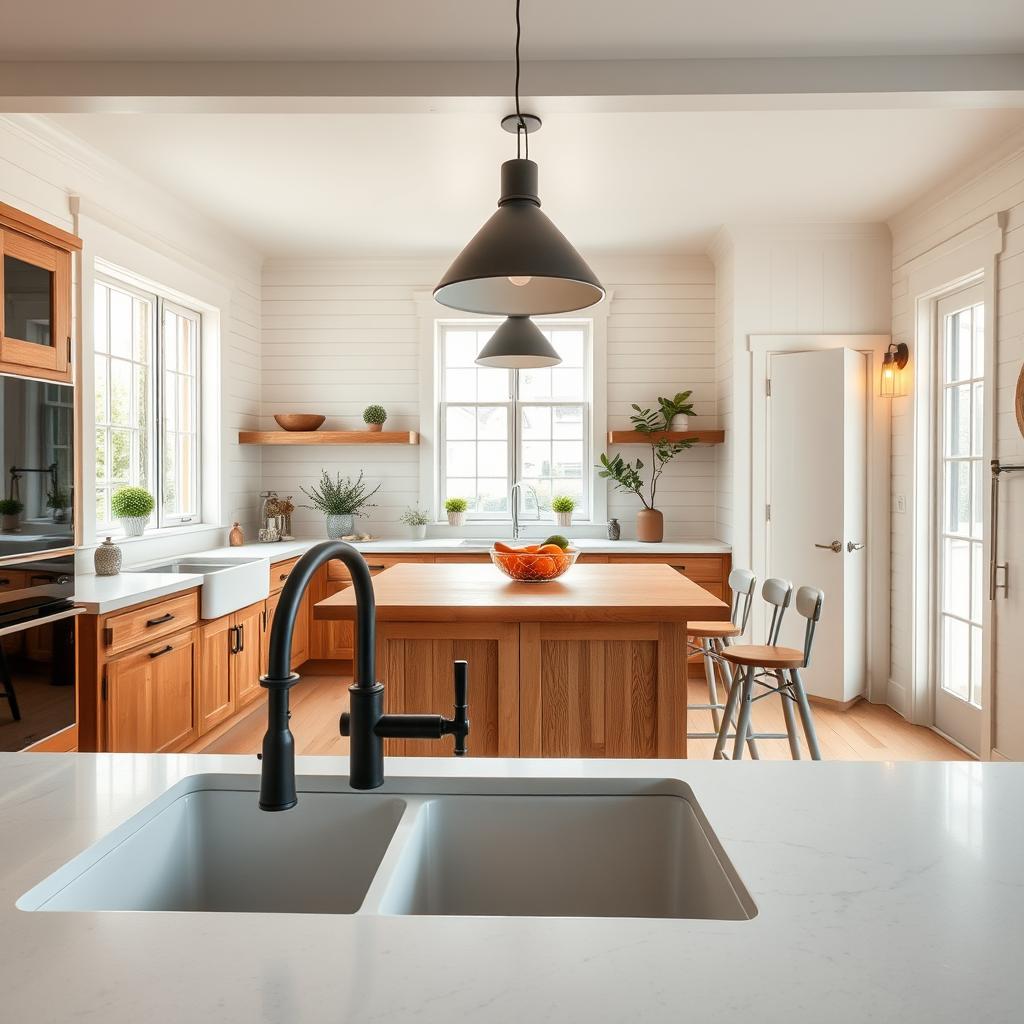
Spaces that tell a story while staying practical never go out of style. The farmhouse style thrives because it mixes heritage with today’s needs. Think weathered wood alongside sleek quartz or apron sinks that feel both nostalgic and fresh.
Why This Style Endures
Its look resonates because it’s adaptable. Families love eat-in tables replacing islands, like Source 1’s quartz-topped designs doubling as homeschool hubs. The elements—wide-plank floors, salvaged beams—add authenticity without sacrificing function.
Apron sinks remain a staple (Source 1’s fireclay picks prove it). They pair perfectly with honed soapstone, as seen in Source 2’s salmon-colored Shaker cabinets. It’s a blend that feels intentional, not staged.
Modern Twists on Classic Farmhouse
Today’s modern farmhouse leans into contrast. Source 3’s rattan stools with black leather seats add edge, while checkerboard green tiles (Source 2) pop against jute rugs. The aesthetic balances old and new effortlessly.
Layered lighting—woven pendants over islands, sconces by sinks—creates warmth. Black-framed windows (Source 2) frame views like living art. Every detail serves a purpose, making the space as usable as it is beautiful.
Choosing the Perfect Farmhouse Cabinetry
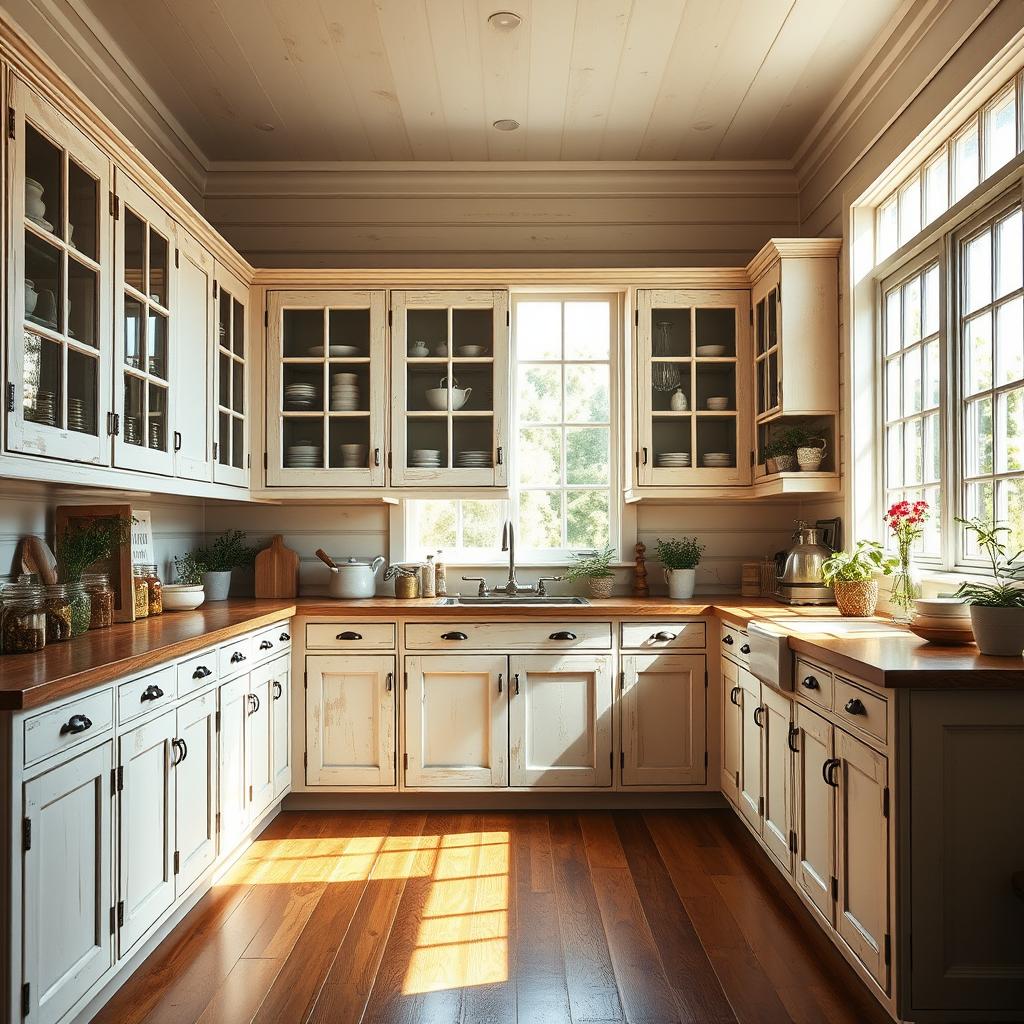
Cabinets set the tone for any kitchen, blending style with everyday function. The right choice balances classic appeal with today’s needs, whether you prefer Shaker details or minimalist flat panels.
Shaker-Style vs. Flat-Panel Designs
Shaker cabinets, like Source 1’s blue-gray and white combo, offer timeless grooves and versatility. Flat-panel designs, such as Source 3’s Olympic Mountains blue, lean into sleek modernity. Both work in farmhouse spaces but cater to different vibes.
Neutral Tones and Hardware Choices
Neutral cabinets—think Source 2’s Palm green or Backdrop’s Skywalker—create a calm backdrop. Pair them with matte champagne pulls (Source 1) or bold black handles (Source 3) for contrast. Beadboard paneling in pantries adds subtle texture.
Pro tip: Lighter cabinets let statement backsplashes shine, like Source 3’s tile examples. Pure & Original Lime Wash offers a weathered finish for those craving extra character.
The Allure of Open Shelving
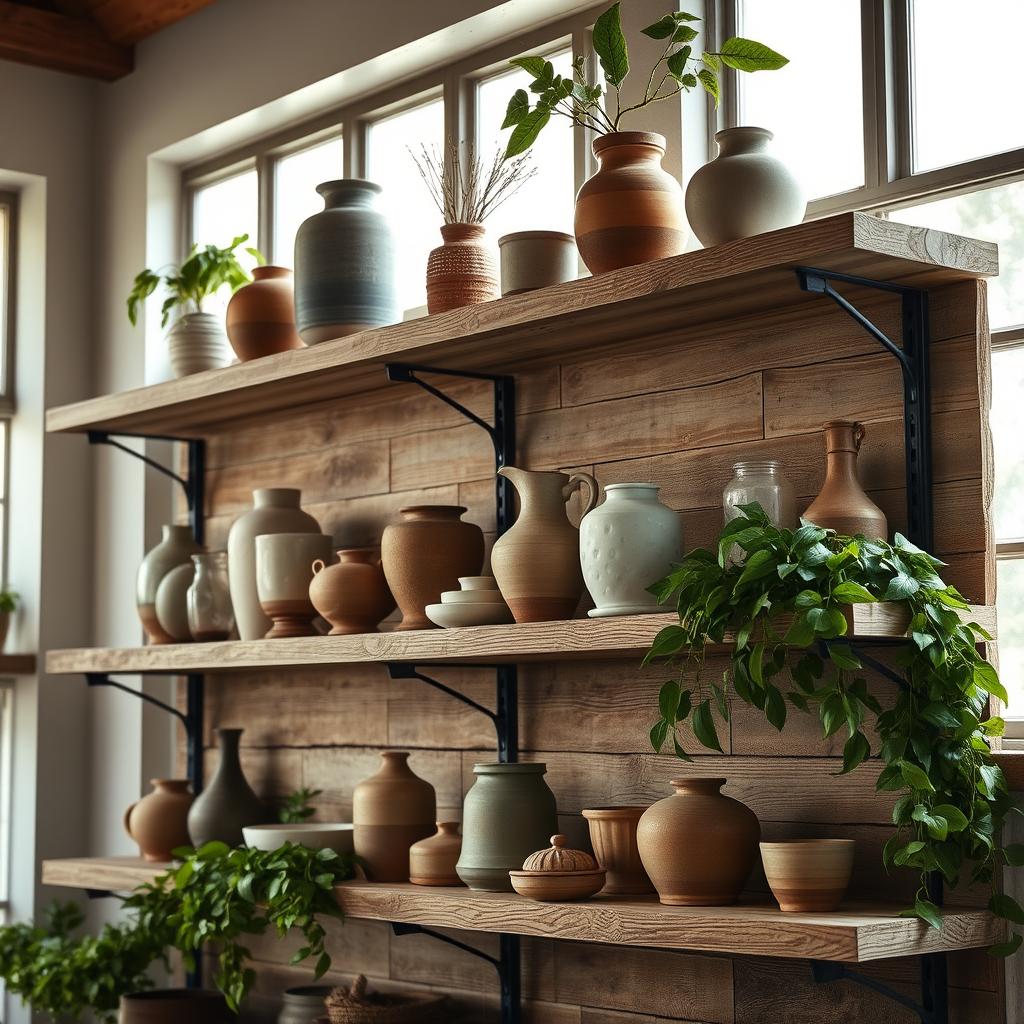
Open shelving brings a sense of airiness while keeping essentials within reach. Unlike closed cabinets, it invites you to showcase favorite items—from heirloom ceramics to daily-use bowls. The key is balancing function with visual appeal.
Styling Tips for Functional Displays
Start by measuring your tallest piece (like a pitcher or vase) and leave 2″ clearance above it. This trick, inspired by Helen Norman’s triple-layer shelves, ensures harmony. Layer flat-woven trays with fresh greenery or stack wooden bowls for texture.
For small spaces, plate racks maximize vertical storage. Avoid overcrowding; let each piece breathe. Thrifted copper pots or neutral ceramics look intentional when spaced thoughtfully.
Mixing Materials for Visual Interest
Pair walnut wood shelves with reclaimed beams for warmth. Source 3’s blend of ceramics and woven textures proves contrast adds depth. Matte black brackets or brass hardware elevate the look.
Pro tip: Rotate seasonal items to keep displays fresh. A curated approach, like Source 1’s antique finds, feels personal without clutter.
Farmhouse Sinks: A Focal Point with Function
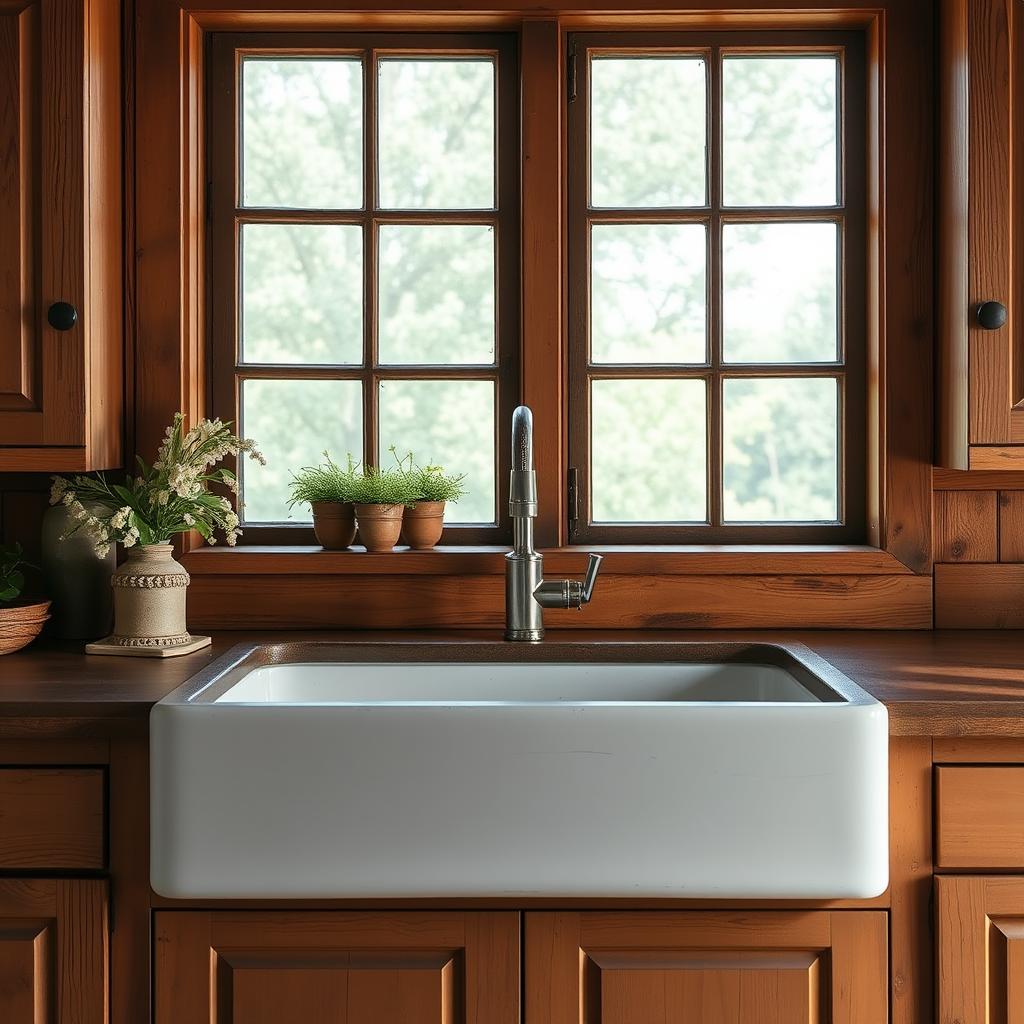
The heart of any functional kitchen lies in its sink selection. A farmhouse sink isn’t just a utility piece—it’s a design anchor. With deep basins and apron fronts, these sinks merge practicality with character, turning daily chores into moments of quiet appreciation.
Porcelain vs. Fireclay Options
Porcelain sinks (like Source 1’s copper-edged pick) resist stains but may chip under heavy use. Fireclay, such as Whitehaus’s sunflower-skirted designs (Source 2), offers superior durability and a matte finish. Both materials bring charm, but fireclay wins for high-traffic spaces.
Source 3’s apron-front models highlight deep basins, ideal for large pots. Pair them with butcher block countertops (Source 1’s tutorial) for a warm, organic contrast.
Pairing with Statement Faucets
Aged brass bridge faucets (Source 3) elevate fireclay sinks, while marble taps (Source 1) add sleek contrast. Source 2’s 30″ proportions work beautifully with gingham curtains—proof that details matter.
Pro tip: Install sinks slightly forward to maximize counter space. This small adjustment enhances both looks and workflow.
Natural Wood Accents for Warmth
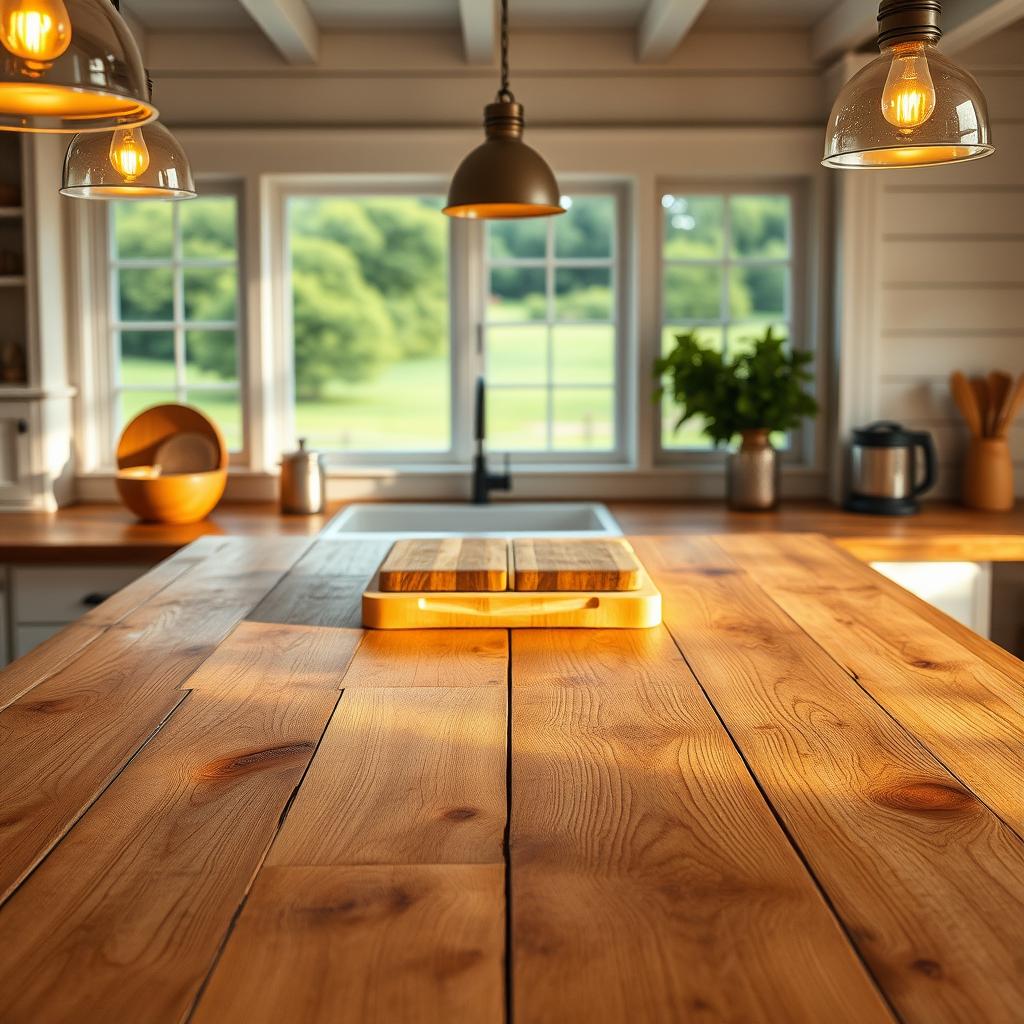
Wood brings an instant warmth to any space, grounding design with organic beauty. Whether it’s a butcher block countertop or reclaimed beams overhead, these elements add character that synthetic materials can’t match. The key is balancing durability with natural charm.
Butcher Block Countertops
Source 1’s DIY tutorial reveals how butcher block shines in busy kitchens. Regular oiling (every 4–6 weeks) prevents cracks and enhances the wood’s rich grain. Pair it with Vermont soapstone sinks (Source 2) for a rugged-meets-refined look.
Cost-saving tip: Use reclaimed wood for accent walls. Source 1’s method avoids waste while adding texture. Just sand thoroughly to avoid splinters.
Reclaimed Wood Beams and Shelves
Source 2’s pine ceilings mimic barn kitchens, with knots and nail holes adding history. Contrast rough oak floors (Source 3) with sleek stools for modern edge. Seal beams annually to prevent warping—Source 3’s wax blend works best.
Solid walnut islands (Source 3) showcase visible grain patterns. Their depth pairs well with matte black hardware, proving natural wood adapts to any style.
Lighting That Elevates the Space
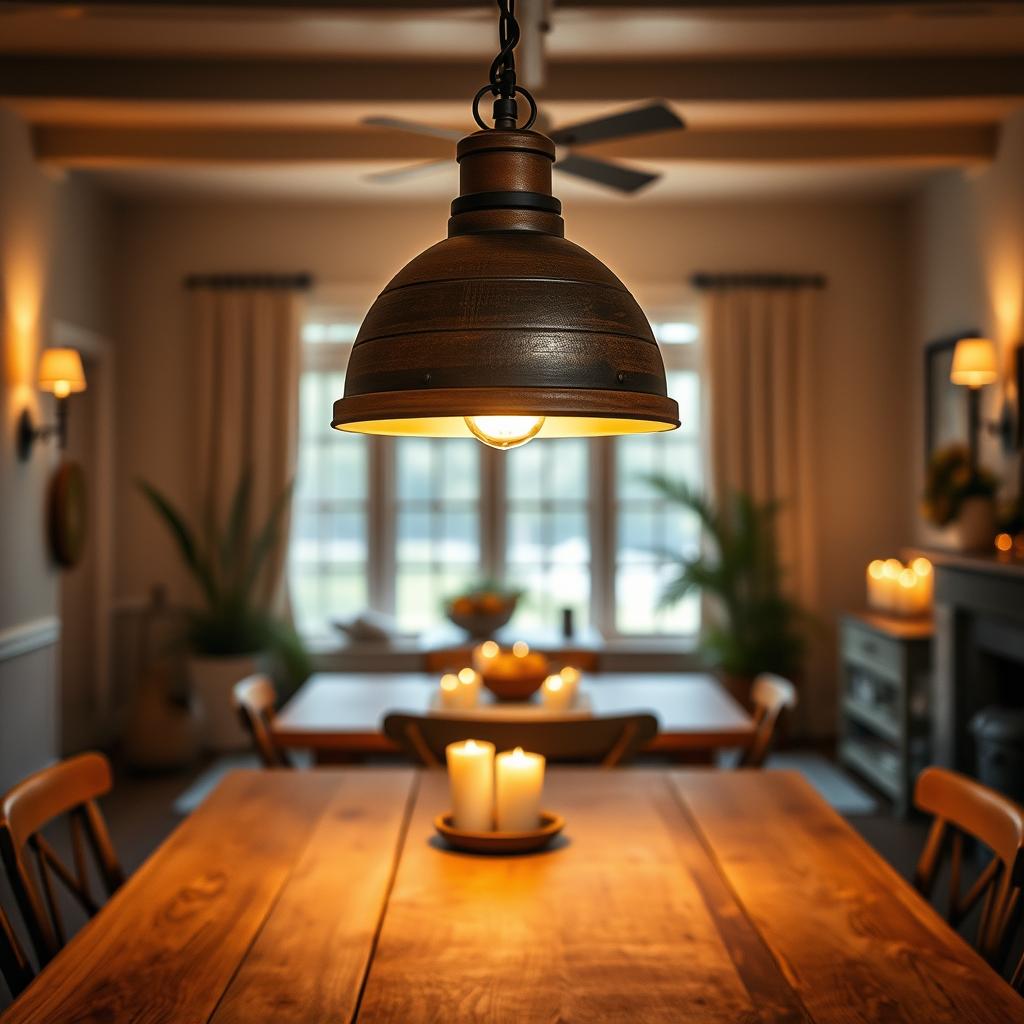
Lighting transforms a room from functional to unforgettable. The right fixtures add warmth, highlight textures, and define zones—turning a kitchen into the heart of the home. It’s where design meets daily life.
Woven Pendant Lights Over Islands
Source 3’s formula—three wicker pendants over an 8′ island—creates balance. The natural fibers soften sleek countertops, while black metal sconces (Source 3) add edge. For smaller spaces, Source 2’s oversize lanterns anchor cabin kitchens effortlessly.
In walk-in pantries, Source 1’s unlaquered brass fixtures pair with woven shades. The mix of matte champagne hardware and rough-hewn beams feels curated, not cluttered.
Layered Lighting for Ambiance
Start with Source 2’s Murano glass chandelier over a farm table. Add task lighting—like sconces by the sink—and under-cabinet LEDs for practicality. The aesthetic shines when each layer serves a purpose.
Don’t overlook focal points. Source 2’s scalloped brass pendant draws the eye upward, proving even small details impact the light. For cozy corners, try dimmable Edison bulbs in Source 3’s black cages.
Earthy and Neutral Color Palettes
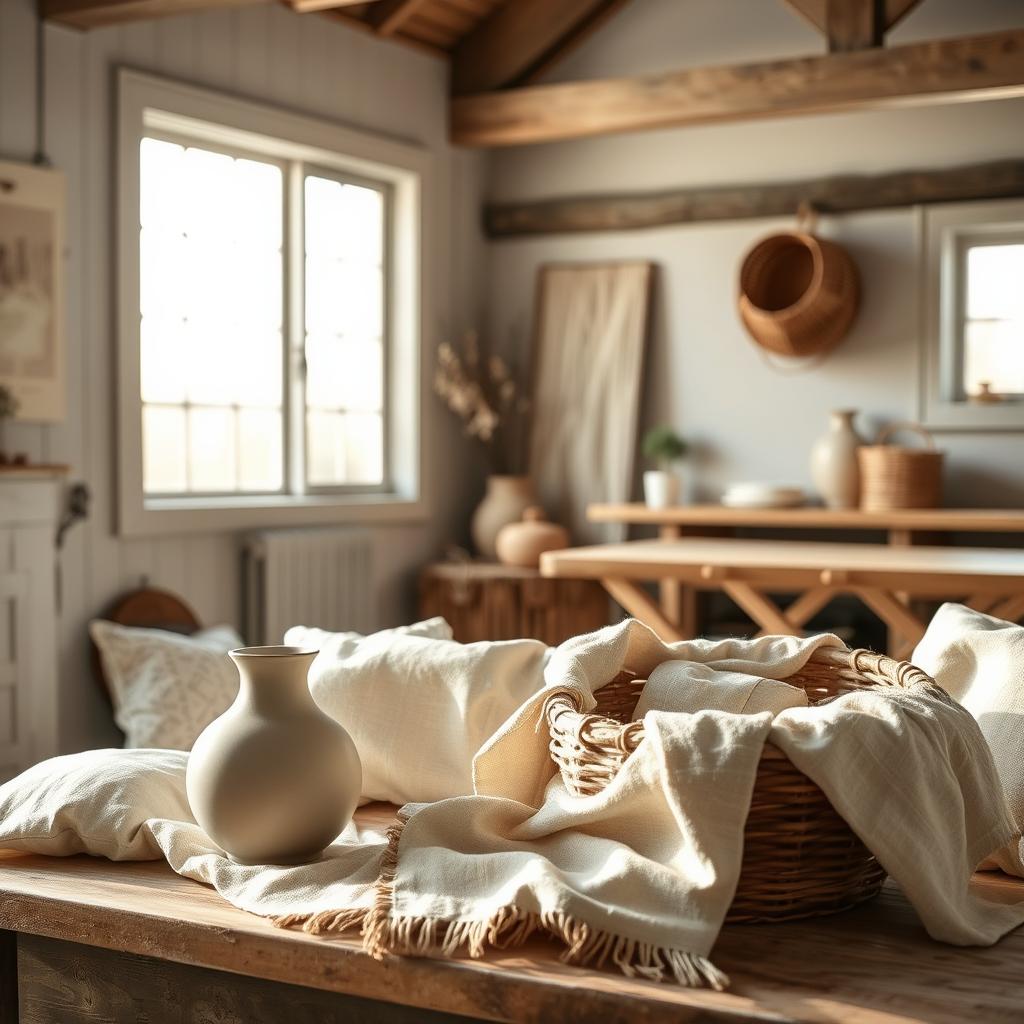
The right colors can transform a room from bland to beautiful in seconds. A balanced palette blends soft hues with bold contrasts, creating harmony. Think creamy whites paired with muted greens or deep blues—each shade adding depth without overwhelming the space.
Soft Greens and Creamy Whites
Source 1’s lime wash in muted tones offers a weathered, organic look. Pair it with Benjamin Moore’s “Ashwood” for walls—a warm gray that complements Farrow & Ball’s “Inchyra Blue” cabinetry (Source 2). These tones feel fresh yet timeless.
Salmon-colored Shaker cabinets (Source 2) prove neutrals can be playful. Layer them with Source 3’s 60-30-10 rule: 60% base color (white), 30% secondary (green), 10% accent (black). The result? A cohesive aesthetic.
Dark Accents for Contrast
Black window frames (Source 3) add modern edge against light walls. Source 2’s checkerboard green tiles pop as backsplashes, while matte black hardware grounds the look. These touches prevent neutrals from feeling flat.
Pro tip: Use Pure & Original’s blue-gray cabinetry (Source 1) as a bridge between light and dark tones. The balance feels intentional, not jarring.
Backsplashes with Character
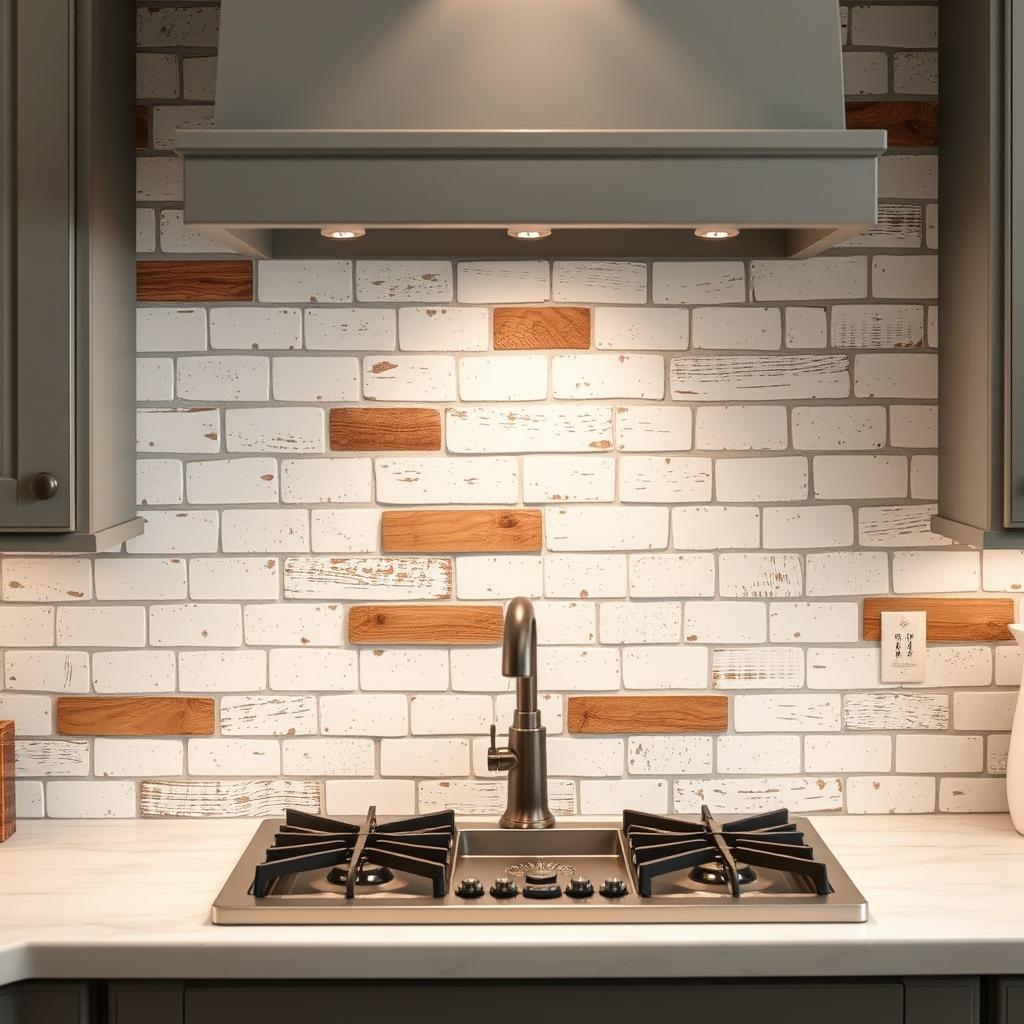
From bold patterns to subtle textures, backsplashes define a kitchen’s character. They protect walls while adding visual interest—a perfect blend of function and design. Whether you prefer vibrant tiles or understated slabs, the right choice elevates the entire space.
Patterned Tiles vs. Seamless Slabs
Source 2’s Lauren Liess “Nostalgia” mosaic tiles bring energy with geometric greens. Pair them with neutral cabinets to let the elements shine. For a cleaner look, Source 1’s marble slabs offer timeless elegance without overwhelming the design.
Polished concrete (Source 3) resists stains and adds industrial flair. Its low-maintenance surface suits busy kitchens. Matte-finish tiles (Source 3) soften light reflection, creating a cozy ambiance.
Textured Plaster for a Rustic Touch
Source 3’s plaster backsplash pairs beautifully with wood shelving, adding organic texture. It mimics aged walls, perfect for a farmhouse vibe. Source 2’s Vermont salvaged sink treatment uses rough-hewn stone for a similar effect.
Pro tip: Balance bold backsplashes with simple countertops. Source 1’s subway tile alternatives prove even small patterns make a statement.
Incorporating Nature Indoors
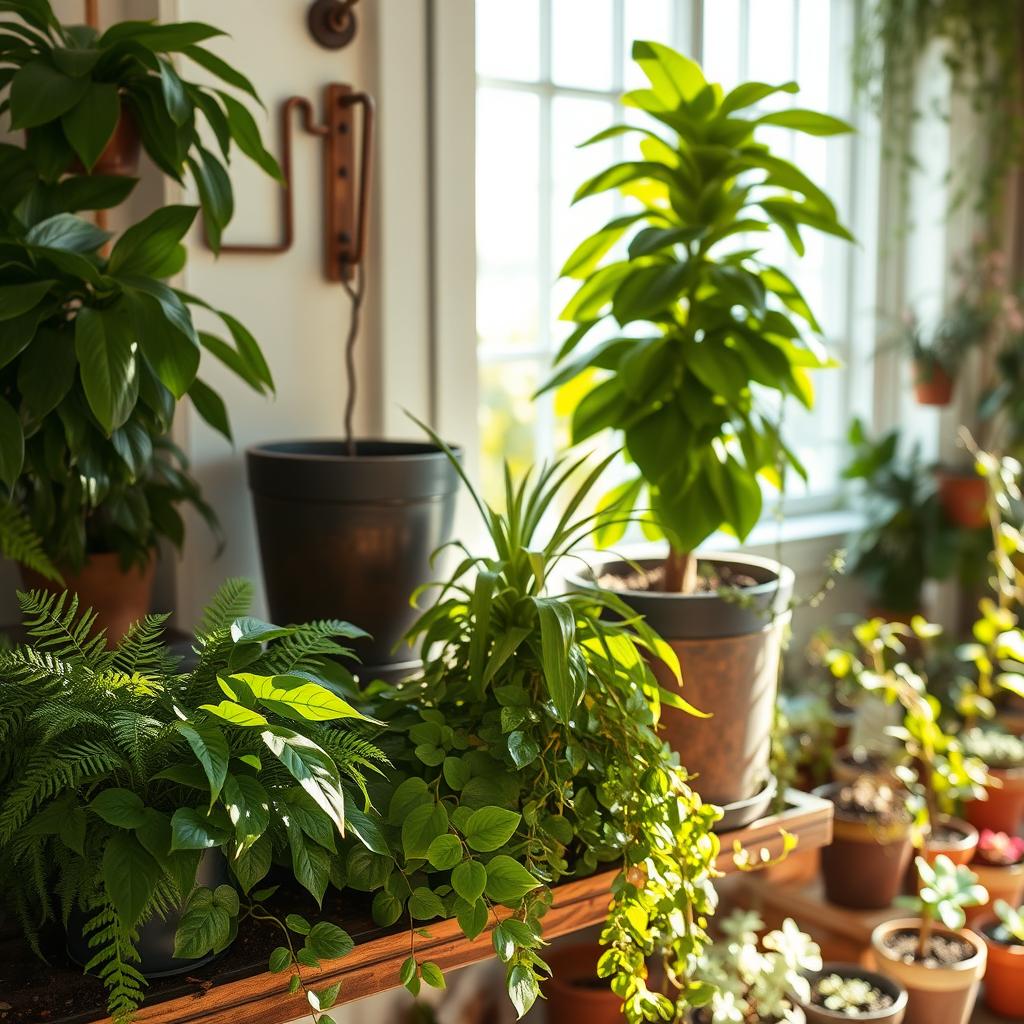
Bringing the outdoors inside creates a calming, organic vibe in any home. Whether through potted herbs or sunlit corners, these touches make a space feel alive. The key is balancing aesthetics with practicality—so greenery and sunlight work seamlessly in daily life.
Potted Herbs and Fresh Florals
Source 1’s vintage containers turn a windowsill into a kitchen herb garden. Thyme, basil, and mint thrive near natural light, adding fragrance and function. For visual appeal, Source 3’s rattan planters with trailing ivy soften wood shelves.
Jute rugs (Source 3) echo outdoor textures underfoot. Avoid clutter—group three ceramic pots with varying heights for rhythm. Pro tip: Rotate blooms seasonally, like Source 2’s wildflower arrangements.
Large Windows for Natural Light
Align windows with prep zones, as Source 3 suggests, to brighten tasks. Source 2’s triple installation over farm sinks frames pastoral views like living art. Bare windows (Source 2) maximize sunlight but need UV protection—Source 1’s linen curtains diffuse glare softly.
For smaller spaces, a single casement window above butcher block (Source 1) adds warmth. The goal? Let light enhance the room’s flow without overwhelming it.
Flooring That Grounds the Design
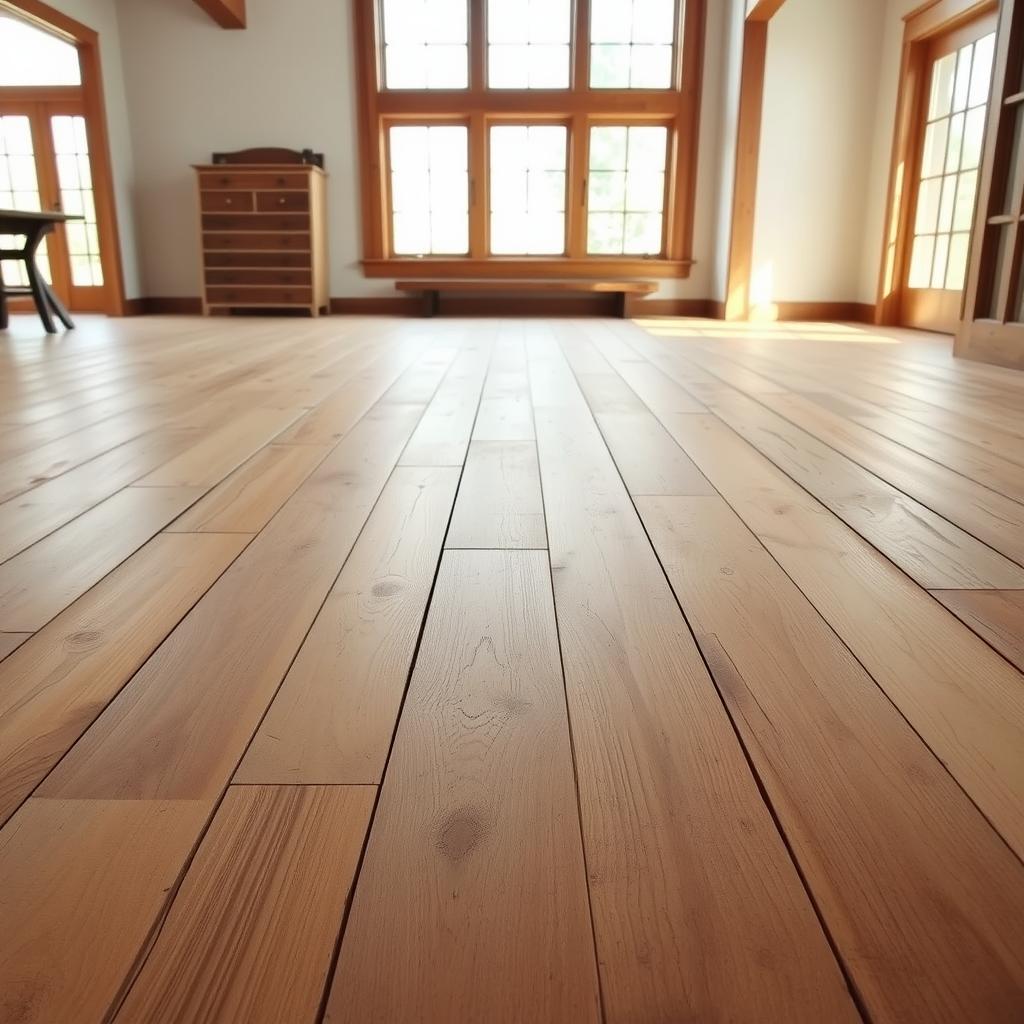
The foundation of any inviting home starts from the ground up. Floors set the tone, blending durability with aesthetic appeal. Whether you prefer the warmth of wood or the practicality of tile, the right choice enhances daily life.
Wide-Plank Wood Floors
Source 1’s DIY wide-plank installation tips highlight how reclaimed oak adds character. These planks, with intentional knots, create a lived-in feel. Source 3’s softened oak stain balances rustic charm with modern refinement.
For contrast, pair rough-hewn floors with sleek stools (Source 3). Source 2’s staining techniques—like North Carolina cabin’s weathered gray—add depth. The key? Let the wood’s natural variations shine.
Neutral Rugs for Added Comfort
Source 1 favors washable natural fiber rugs for high-traffic areas. Jute or sisal adds texture without overwhelming the space. Thrifted vintage rugs (Source 1’s tip) layer personality underfoot.
Moroccan cement tiles (Source 2) offer durability for busy homes. But for coziness, Source 3’s wool blends soften oak’s grain. Pro tip: Rotate rugs seasonally to refresh the look effortlessly.
Vintage and Antique Decor Touches
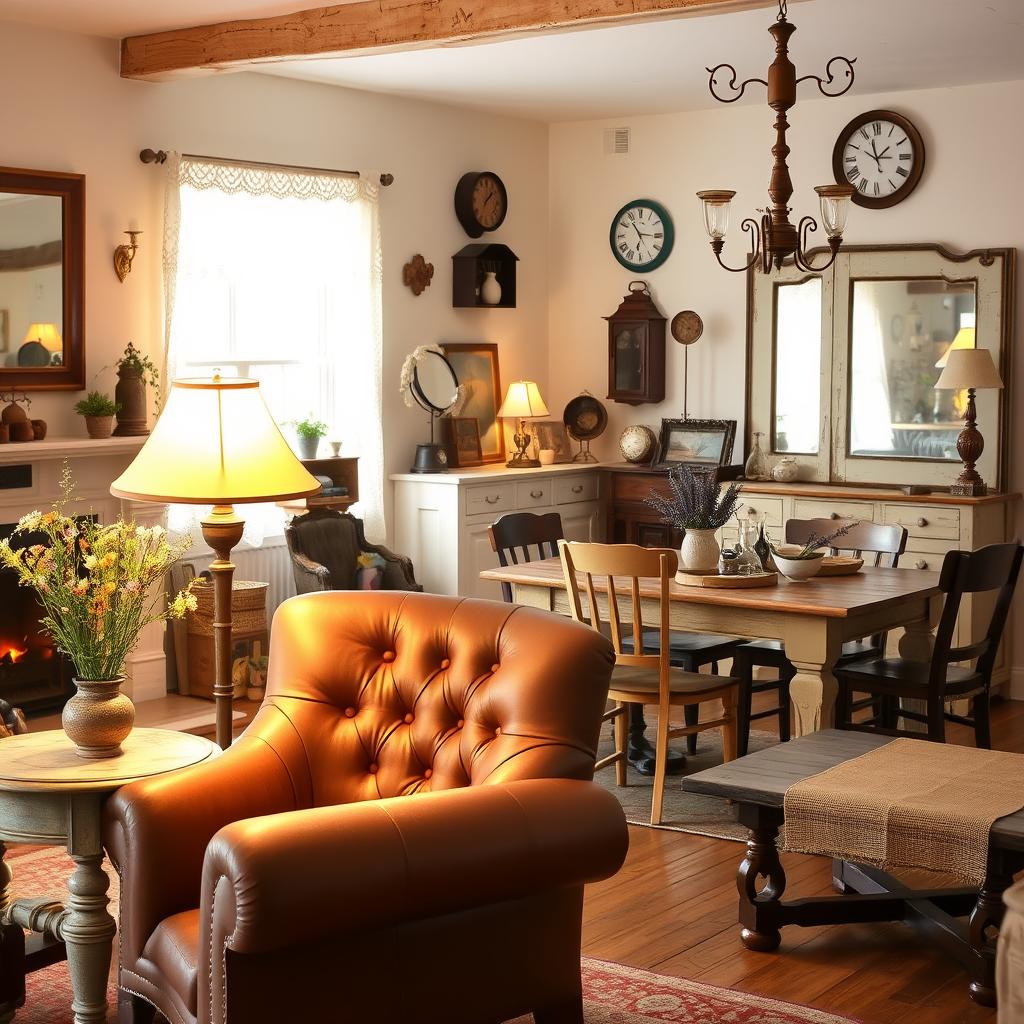
Vintage pieces add soul to a space, turning everyday items into conversation starters. Whether it’s a weathered cutting board or a hand-me-down pitcher, these treasures bring depth to your home. The key is blending them thoughtfully for a curated look.
Displaying Heirloom Kitchenware
Source 1’s antique cutting board wall display proves even functional pieces can be art. Group mismatched boards in a grid for impact, or prop them on open shelves alongside Source 3’s ceramic dish collections. The mix of textures adds subtle charm.
For hidden storage, try Source 1’s curtained lower cabinets. Linen panels soften the farmhouse aesthetic while keeping clutter out of sight. Built-in hutches (Source 2) showcase ironstone beautifully—stack plates vertically for drama.
Repurposing Found Items
Source 2’s Facebook Marketplace dry sink conversion turns salvage into a statement. Sand rough edges, add fresh paint, and voilà—a unique island or bar. Wooden crates (Source 2) become plate racks, while midcentury chandeliers (Source 3) add contrast overhead.
Thrifting tips: Source 1’s flea market routes yield authentic finds. Look for patina—chipped paint or worn handles tell a story. A single vintage scale or bread box can anchor a shelf with history.
Creating Your Dream Farmhouse Kitchen
Designing a welcoming space starts with blending function and style. Think of Source 1’s linen cabinet curtains paired with Source 2’s unfitted layouts—flexible yet full of character.
Mix materials for depth, like Source 3’s walnut shelves with brass hardware. Start with a focal point, such as a sturdy farmhouse table (Source 2), to anchor the room.
Balance is key. A table that doubles as a homeschool hub (Source 1) proves practicality matters. Let imperfections shine, as Source 3 suggests—chips and wear tell your home’s story.
Your design should feel lived-in, not perfect. Combine these elements to create a farmhouse kitchen that’s uniquely yours.
If you want to read more article,please click here.
If you want to know more,then click here.
Leave a Reply